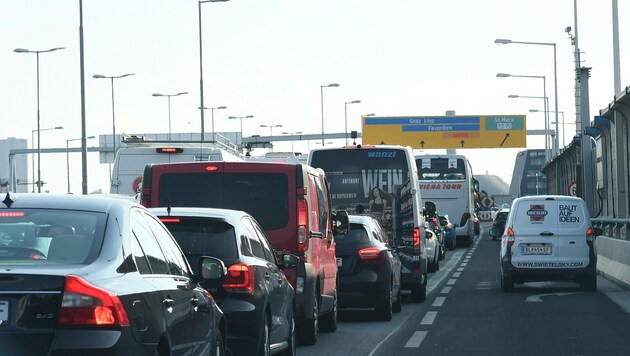New traffic analysis
Why the south of Vienna remains a traffic jam
After the coronavirus slump, commuter flows have increased again. And there is no solution in sight for the south of Vienna either.
For the further expansion of public transport in eastern Austria, it is important to see where the service is still poor or not accepted. The so-called Kordon survey provides a good indication of this. It provides a comprehensive overall picture of the traffic flowing into Vienna.
The latest evaluation from 2022 is now available - and it contains some interesting aspects. In contrast to previous analogue survey methods, anonymized mobile phone data has now also been evaluated. They allow a closer look at the morning traffic jams.
617.000
people roll into Vienna every day. The south of Vienna in particular suffers from the rush of commuters.
Only just under a quarter commute by public transport
This is because 77 percent of commuters still use their cars. Only 23 percent rely on getting to the office on time by bus or train. Why are people stuck in traffic jams on the Tangente in the morning? The Mödling and Bruck an der Leitha corridors are by far the largest corridors for commuters - and there are over 617,000 of them every day.
Interestingly, around 3,000 more people commute to the surrounding municipalities every day than Lower Austrians and Burgenlanders commute to Vienna.
In Vienna, almost three quarters of people travel by public transport, bicycle or on foot. We now need sustainable mobility in the surrounding area.
Thomas Madreiter, Planungsdirektor Wien
A ray of hope: The detailed analysis also shows that bus and rail travel has increased by 28.5 percent since the last comprehensive survey in 2010. In comparison, car traffic has only increased by around five percent during this period despite strong population growth.
"Vienna cannot solve the problem alone"
Why does the south of Vienna still play the leading role in traffic news every morning? The City of Vienna does not see itself as the main culprit here. When asked why the expansion of public transport in the south of Vienna is failing, they say: "The current figures clearly show that urgent measures are needed in the surrounding area, Vienna cannot solve the problem on its own: Supra-regional measures are needed, such as the swift implementation of the agreed expansion of the rail infrastructure, such as a four-track southern line, capacity expansion of the main line, etc."
And what needs to happen so that the south of Vienna is no longer a traffic jam hell at peak times? The city's answer: "Supra-regional streetcar projects such as the Liesing-Perchtoldsdorf-Kaltenleutgeben city streetcar and regional buses are also needed to reduce car journeys." Conclusion: Vienna has done everything right. So the congested roads are not their fault.
In Vienna, the Viennese rely on public transport
However, the traffic analysis in the city itself shows that there is another way. The situation within the city limits is exactly the opposite of that of commuters: The Viennese use cars for 26 percent of their journeys within the city, while almost three quarters of them use eco-mobility, i.e. walking, cycling or public transport (30 percent). Only the south of Vienna has little of this.
This article has been automatically translated,
read the original article here.












Kommentare
Da dieser Artikel älter als 18 Monate ist, ist zum jetzigen Zeitpunkt kein Kommentieren mehr möglich.
Wir laden Sie ein, bei einer aktuelleren themenrelevanten Story mitzudiskutieren: Themenübersicht.
Bei Fragen können Sie sich gern an das Community-Team per Mail an forum@krone.at wenden.